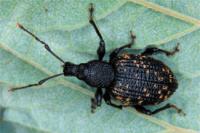Controlling Vine Weevils
 Vine Weevils are a member of the beetle family
Vine Weevils are a member of the beetle familyThe Vine weevil can be one of the most prolific pests in the garden, attacking on two fronts.
Have you ever had a pot plant or garden plant that appears poorly and then suddenly collapses? Do you have any shrubs in your garden that have notches cut out from around the leaf margins? These symptoms are characteristic of the vine weevil.
Weevils are part of the beetle family. Vine weevils (Otiorhyncus sulcatus) are distinctive because they have longer snouts than other beetles.
Adult Vine Weevils
Adult vine weevils feed at night, they are about 1cm long and have black, rough textured bodies that are freckled with rusty-grey spots.
If you have house plants, you may from time to time discover an adult vine weevil wandering around the kitchen or living room, they are slow moving and not able to fly, but are very good climbers.
Adult females vine weevils lay eggs in soil or compost during late summer and early autumn. The damage caused by adult vine weevils is mainly cosmetic, they eat out unsightly notches around leaf margins making affected commercial nursery stock unsuitable for sale.
Adult vine weevils seem to have a particular taste for Rhododendron and Bergenia (Elepahant's ears) foliage.
Vine Weevil Larvae
After adult vine weevils lay eggs in the soil or compost the larvae hatch.
The larvae are creamy-white in colour, legless and have a distinctive tanned chestnut coloured head. When discovered, the larvae curl up into a c-shape.
Vine weevil larvae particularly affect container grown plants and were a big problem on commercial scale nurseries. However, in recent years various controls have come on to the market to help both commercial and amateur growers reduce the impact of this pest.
The vine weevil has been so successful as a pest because the larvae feed on plant roots below soil level. For the untrained eye, noticeable symptoms are not evident until the larvae have almost finished their feast and the victim is about to collapse, having had it's foundations destroyed by the larvae.
Vine weevil larvae seem to have a particular taste for Cyclamen and Begonia roots. They also like the roots of strawberry plants and Primulas.
Personally, before I learnt to spot the tale-tale signs of weak, stunted plant growth I had Heuchera and Penstemon plants demolished in my own garden.
By early winter, the larvae pupate in the growing medium, developing into the adult weevils.
Organic controls
If you want to be totally organic, you can go out at night to collect and kill the slow moving adult weevils from affected plants. Another organic method that I have not used, but have read about for controlling vine weevil is the use of rolled up corrugated paper. This can be placed near affected plants, adult wine weevils take shelter under the paper during the daytime, they can then be caught and destroyed.
Another option is to smear vaseline around the rims of pot grown plants, preventing access to the adults. The soil surface of pot plants can be mulched with sharp gravel, providing a physical barrier to the adults burrowing down into the compost to lay their eggs.
Another biological control that is available for the control of vine weevil is a product that can be added to a watering can when watering affected plants. This product contains millions of tiny nematodes that collectively feed on the vine weevil larvae. When using the product containing the nematodes, it is important to use it only use it when temperatures are warm enough during the growing season because otherwise the nematodes will not be active.
Such products are usually only available from specialist biological control suppliers, usually by mail order.
If you discover vine weevil in the soil or compost, dispose of the growing medium from the immediate affected area and the affected plant, don't put this on the compost heap however as you do not want it to end up back on the garden.
Adults vine weevils hide by day, good housekeeping is important to try and limit the number of hiding places. Remove any plant debris from around the base of pot plants as this will probably provide daytime shelter for adult vine weevils.
Chemical controls
If you prefer to use a chemical to control vine weevil, there is a product called Provado that is readily available.
If after reading this article you would like to prevent vine weevil attacks rather than cure the problem when it has already arrived there are composts available that contain chemicals specially designed to prevent vine weevil. These composts claim to be effective for up to one year so it is important to regularly change the compost.
For more information see:
Buy Vine Weevil control products online...
Filed under Pests & Diseases.

